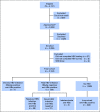Models to Predict Hepatitis B Virus Infection Among Patients With Cancer Undergoing Systemic Anticancer Therapy: A Prospective Cohort Study
- PMID: 29447061
- PMCID: PMC7351320
- DOI: 10.1200/JCO.2017.75.6387
Models to Predict Hepatitis B Virus Infection Among Patients With Cancer Undergoing Systemic Anticancer Therapy: A Prospective Cohort Study
Erratum in
-
Errata.J Clin Oncol. 2020 Aug 1;38(22):2599. doi: 10.1200/JCO.20.01840. J Clin Oncol. 2020. PMID: 32729792 Free PMC article. No abstract available.
Abstract
Purpose: Most patients with cancer are not screened for hepatitis B virus (HBV) infection before undergoing anticancer therapy, and optimal screening strategies are unknown. We sought to develop selective HBV screening strategies for patients who require systemic anticancer therapy.
Methods: This prospective cohort study included adults age ≥ 18 years with solid or hematologic malignancies who received systemic anticancer therapy at a comprehensive cancer center during 2013 and 2014. Patients underwent hepatitis B surface antigen, hepatitis B core antibody, and hepatitis B surface antibody testing, and completed a 19-question modified Centers for Disease Control and Prevention (CDC) HBV survey. Multivariable models that predict chronic or past HBV infection were developed and validated using bootstrapping.
Results: A total of 2,124 patients (mean age, 58 ± 13 years) completed the risk survey and HBV testing. Of these, 54% were women; 77% were non-Hispanic white, 11% Hispanic, 8% black, and 4% Asian; and 20% had a hematologic malignancy and 80% a solid tumor. Almost 12% were born outside the United States. The prevalence was 0.3% for chronic HBV infection and 6% for past HBV infection. Significant predictors of positive hepatitis B surface antigen or hepatitis B core antibody tests were as follows: men who had sex with men, black or Asian race, birthplace outside the United States, parent's birthplace outside the United States, household exposure to HBV, age ≥ 50 years, and history of injection drug use. The area under the receiver operating characteristic curve of the model on the basis of these seven predictors was 0.79 (95% CI, 0.73 to 0.82). The modified CDC survey and brief tools with fewer than seven questions yielded similar false-negative rates (0% and 0% to 0.7%, respectively).
Conclusion: An internally validated risk tool performed as well as the modified CDC survey; however, more than 90% of patients who completed the tool would still require HBV testing. Universal HBV testing is more efficient than risk-based screening.
Figures
Comment in
-
Screening for Hepatitis B Virus Infection: Are We Asking the Right Questions?J Clin Oncol. 2018 Apr 1;36(10):935-936. doi: 10.1200/JCO.2018.77.7128. Epub 2018 Feb 22. J Clin Oncol. 2018. PMID: 29470142 No abstract available.
References
-
- Weinbaum CM, Williams I, Mast EE, et al. :Recommendations for identification and public health management of persons with chronic hepatitis B virus infection. MMWR Recomm Rep 57:1-20, 2008 - PubMed
-
- American Association for the Study of Liver Diseases : AASLD practice guideline update: Chronic hepatitis B: Update 2009. www.aasld.org/practiceguidelines/Documents/Bookmarked%20Practice%20Guide...
-
- Reddy KR, Beavers KL, Hammond SP, et al. : American Gastroenterological Association Institute guideline on the prevention and treatment of hepatitis B virus reactivation during immunosuppressive drug therapy. Gastroenterology 148:215-219, quiz e16-e17, 2015. [Erratum: Gastroenterology 148: 455, 2015] - PubMed
-
- Baden LR, Swaminathan S, Angarone M, et al. : Prevention and treatment of cancer-related infections, version 2.2016, NCCN Clinical Practice Guidelines in Oncology. J Natl Compr Canc Netw 14:882-913, 2016 - PubMed
Grants and funding
LinkOut - more resources
Full Text Sources
Other Literature Sources
Miscellaneous


